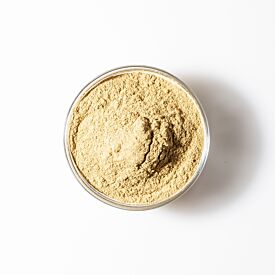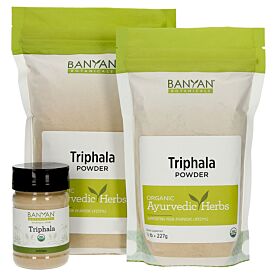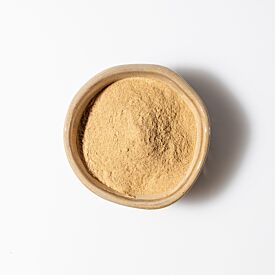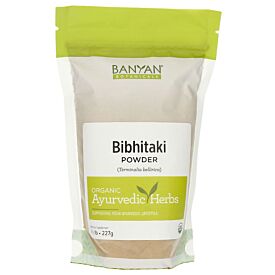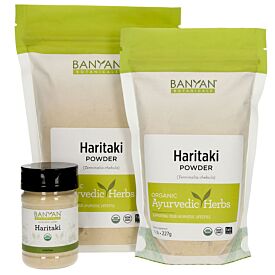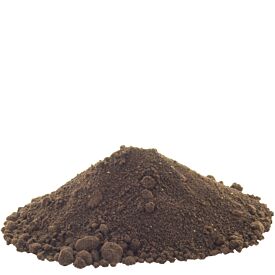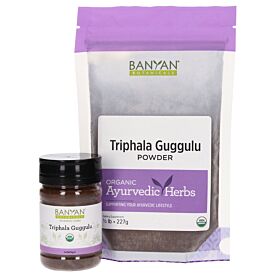The Benefits of Triphala
Triphala is one of the most well-known and commonly used formulas in Ayurveda. With a unique ability to detoxify and rejuvenate the body, along with a host of other benefits, this traditional herbal formula is one of the true staples of an Ayurvedic lifestyle.
In this article:
- What Is Triphala?
- Benefits of Triphala
- How to Take Triphala
- Is Triphala Safe?
- Scientific Research on Triphala
- Growing and Harvesting Banyan’s Triphala
What Is Triphala?
Triphala is not a single fruit, plant, or herb, but rather an herbal formulation—one of the most popular and commonly used formulas in Ayurveda!
Literally meaning “three fruits,” triphala (also known as "triphala churna") is a traditional Ayurvedic blend consisting of three simple ingredients, each one a beneficial fruit native to the Indian subcontinent: amla (Emblica officinalis), bibhitaki (Terminalia bellirica), and haritaki (Terminalia chebula).
The many triphala benefits that make this blend so widely renowned extend to all three doshas, making it an excellent choice for almost everyone. Not sure what your dosha constitution and state of balance is? Take the free dosha quiz to find out!
Benefits of Triphala
At this point you may be wondering, if this simple formula is so famous in Ayurveda what is triphala good for anyways? Here are some of its common uses:
-
Rejuvenates the tissues and assists natural internal cleansing*
Triphala is a popular balancing formula for detoxification and rejuvenation. It is a natural sources of tannins, phytosterols, and flavonoids that help maintain healthy digestion and support in natural cleansing of the body.1
-
Supports regularity and relieves occasional constipation*
Triphala is most commonly known for its use as a gentle bowel tonic, helping to support regular, healthy elimination and relieve occasional constipation. While many notice immediate benefits and have great success using triphala, it is not intended to treat chronic constipation.2
-
Supports digestion and promotes a healthy gut microbiome*
With an affinity for the entire GI tract, triphala works to enhance digestion and absorption, keeping the body feeling properly nourished and balanced. It has also been shown to support a healthy gut microbiome.3
-
Supports a Healthy Inflammatory Response*
One of major phytoconstituents naturally found in fruits of triphala is gallic acid, a plant polyphenol compound known to support healthy inflammatory response and recognized as an antioxidant.4
-
Helps support and maintain a healthy weight*
Triphala and weight loss go hand in hand, especially when seeking a natural approach to weight management. Along with diet and proper exercise, healthy digestion and elimination are important factors in achieving an optimal body weight.
Triphala has been shown to promote healthy lipid and cholesterol levels.5 It also promotes healthy eating habits and tempers unhealthy cravings by supplying the body with the full spectrum of natural tastes.
In addition to these triphala benefits, Ayurveda uses triphala to support proper function of the circulatory, respiratory, and cardiovascular systems.6,7 It has also been shown to be a powerful antioxidant, protecting cells from the damaging effects of free radicals.8,9
The three fruits involved in making triphala are also known for their individual benefits:10
- Amla (Amalaki) (Emblica officinalis) has a cooling effect that helps to balance pitta dosha. A natural source of antioxidants, it also boasts a concentrated amount of vitamin C, making it a powerful support for the immune system.11
- Bibhitaki (Terminalia bellirica) is particularly good for kapha dosha and contains a specific constituent called beta-sitosterol, a plant-derived phytosterol, which is known to support healthy metabolic function.12
- Haritaki (Terminalia chebula) has a warming nature that supports all three doshas, especially vata. Traditionally known for its “scraping” and detoxifying effect, it has also been shown to contain the beneficial constituent beta-sitosterol.13
Triphala and Ayurveda: Traditional Uses
Triphala is recommended and used more often than any other formulation made with Ayurvedic herbs. In Ayurvedic terms, it is said to have a beneficial effect on all three doshas.
Triphala is most well-known for its gentle effects on the bowels, improving peristalsis and cleansing toxic build up of wastes; but Ayurveda also views triphala as a nourishing supplement with an ability to rejuvenate healthy tissues, allowing one to age gracefully.
- The Caraka Samhita, one of the main texts of Ayurveda, describes haritaki as the remover of disease and promotes haritaki and amla for rasayana, or rejuvenation of the body.14,15,16
- For those with sluggish digestion and build up of ama, triphala is said to kindle the digestive fire and help improve agni, allowing one to get the most nutrition from one’s dietary intake.17
- Culturally, haritaki is given the highest respect for restoring health. The Medicine Buddha is often depicted with a haritaki fruit held in his hand—it is said to give the blessing of long life, and along with amalaki and bibhitaki, will nurture you like a mother.18

How to Take Triphala
Determining the Best Time to Take Triphala
As you incorporate triphala into your daily health routines, you may wonder exactly when to take triphala churna, and can triphala be taken daily? Here’s our take, from an Ayurvedic perspective.
When to Take Triphala
In general, triphala should be taken on an empty stomach about 8–10 hours before the colon is naturally most active. For most people, this means taking triphala at bedtime, first thing in the morning, or both. We encourage you to experiment and find what works best for you.
If you’re wondering exactly how to take triphala churna at night or in the morning, these are a few common methods.
Triphala Tea
The most traditional way to receive the health benefits of triphala is by ingesting it as a tea. This method allows you to taste the herb fully, which is considered by Ayurveda to be an important part of the healing process. Taste activates the digestive process and sends signals to the body as to what to expect, initiating its own inner healing mechanisms.
To take triphala as a tea, make a decoction by adding 1/2 teaspoon of triphala powder to a cup of hot water. Stir and allow the tea to cool, then drink. Alternatively, you can allow the triphala to soak overnight and strain the powder in the morning. If you're wondering, "Will the strained liquid still have the same benefits?", the answer is yes!
Triphala contains five of the six tastes recognized in Ayurveda (sweet, sour, bitter, pungent, and astringent), only missing the salty taste. Perhaps because the Western diet is so lacking in bitter and astringent, these are the two most prominent tastes for most people, which can make drinking the tea somewhat unpleasant initially.
Triphala is balancing for all doshas, but you may be asking, "Will hot triphala tea aggravate my pitta dosha?" Not necessarily—while heat can be pitta-aggravating, triphala's cooling ingredients (especially amalaki) will help balance that heating action. You can also allow the tea to cool to warm or room temperature before drinking it.
Triphala Tablets
Triphala tablets provide a more convenient method of taking herbs, especially for those who travel a lot, have a shortage of time, or do not like the taste of triphala tea.
Many Ayurvedic practitioners prefer to give their patients triphala tablets instead of triphala capsules as there is still a subtle tasting of the herbs that occurs, sending signals to the digestive system to get to work.
Triphala liquid extract
Triphala liquid extract provides an alternative method of taking triphala. It's convenient, easy to assimilate, and has a long shelf life. This extract is made from the same certified organic fruits used in making the herbal tablets and is extracted using non-GMO, gluten-free grain alcohol.
A typical dose is a dropper full (about 30 drops) taken in 1–2 ounces of water or juice, one to three times daily, or as directed by your healthcare practitioner.
Other Methods
In addition to these methods, there are several other ways to use triphala to support your health. It can be used to create a triphala face mask, a hair wash, and even an eye wash. If you're curious to try a triphala eye wash, make sure the powder is strained well and we recommend seeking the guidance of a qualified Ayurvedic practitioner.
Is Triphala Safe?
Triphala Side Effects
Triphala is a natural detoxifying formula. As part of the cleansing process, it is not uncommon for toxins to be released from the deeper tissues and enter the bloodstream on their way to being ushered out of the body. When many toxins are released at once, it can prompt what may be considered triphala side effects. For some people, this can manifest as a headache, a rash, or nausea, in addition to gas, upset stomach, and diarrhea.
Since triphala supports healthy elimination, it is not uncommon to experience looser bowel movements than usual. All of these reactions can be byproducts of cleansing. If your cleansing experience becomes too intense, you can stop taking triphala until the symptoms subside or simply reduce the amount you are ingesting. If the symptoms persist, it is best to discontinue use and consult a practitioner.
Contraindications
Triphala is not intended to support chronic constipation, which can be a sign of an underlying condition and may require practitioner support.
Contraindications can include diarrhea, dysentery, and if you are pregnant or nursing. There are no known drug interactions with the herbs that make up triphala.19,20 Some studies do report findings that would advise caution in people taking blood-thinning medicines,21,22 as triphala may affect platelet function.
From an Ayurvedic perspective, if your stools are dry and hard, consider using haritaki in place of triphala.
Modern Research and Scientific Studies on Triphala
As the knowledge of Ayurveda has gained momentum in the west in recent years, it has led to a significant amount of scientific study on the properties of triphala and other traditional Ayurvedic herbs and blends. The following scientific papers and research studies outline some of the benefits of triphala:
- Exploring Scientific Validation of Triphala Rasayana in Ayurveda as a Source of Rejuvenation for Contemporary Healthcare. PubMed Abstract. 2021.23
- Modulatory Effects of Triphala and Manjistha Dietary Supplementation on Human Gut Microbiota: A Double-Blind, Randomized, Placebo-Controlled Pilot Study. PubMed Abstract. 2020.24
- Study of the Safety of Oral Triphala Aqueous Extract on Healthy Volunteers. PubMed Abstract. 2019.25
- Triphala: Current Applications and New Perspectives on the Treatment of Functional Gastrointestinal Disorders. PubMed Abstract. 2018.26
- Therapeutic Uses of Triphala in Ayurvedic Medicine. PubMed Abstract. 2017.27
- The Effect of Triphala and Chlorhexidine Mouthwash on Dental Health. PubMed Abstract. 2011.28
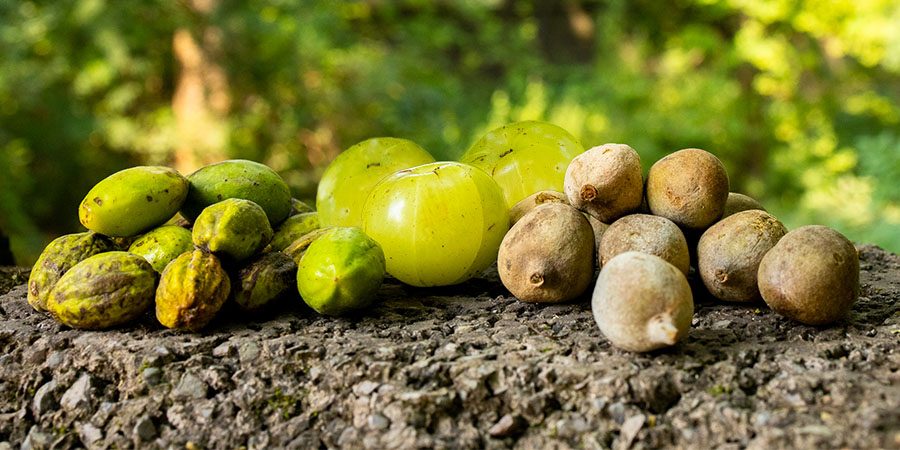
Growing and Harvesting Banyan's Triphala and Certified FairWild Triphala Tablets
The three fruits that combine to make triphala grow on trees that are relatively abundant in many parts of India. They can be found growing naturally in the wild and are also cultivated on privately owned farms.
Harvesting and processing the fruits in triphala is labor-intensive. It includes the picking of the fruits by highly skilled tree climbers, then washing, drying, and removing the pits.
Banyan strongly believes in maintaining socially responsible relationships with our sourcing partners. We are committed to Fair Trade principles and proud to offer Triphala tablets that are certified FairWild and certified Fair for Life Fair Trade. This ensures that we pay above-market wages and invest in the education and well-being of our farmers, wild collectors, and their communities.
Sustainability of Triphala
While the trees that provide the fruits for triphala are not hard to find in India, where and how the fruits are harvested makes a big difference in sustainability. To ensure long-term sustainability, Banyan sources amalaki, bibhitaki, and haritaki that have either been cultivated on privately owned farms or gathered from ethical and sustainable sources.
As a part of a larger conversation regarding the sustainability of Ayurvedic herbs, it is important to understand where and how plants are grown and harvested when you’re making your purchasing decisions.
At Banyan, our herbs and ingredient-producing plants are harvested at optimal times, using environmentally responsible practices sensitive to the long-term health of the plants.


